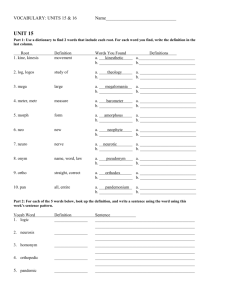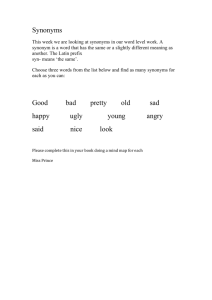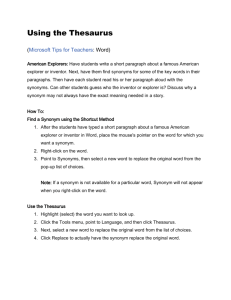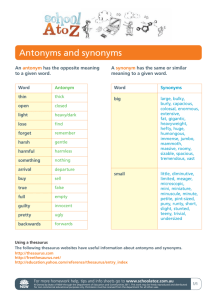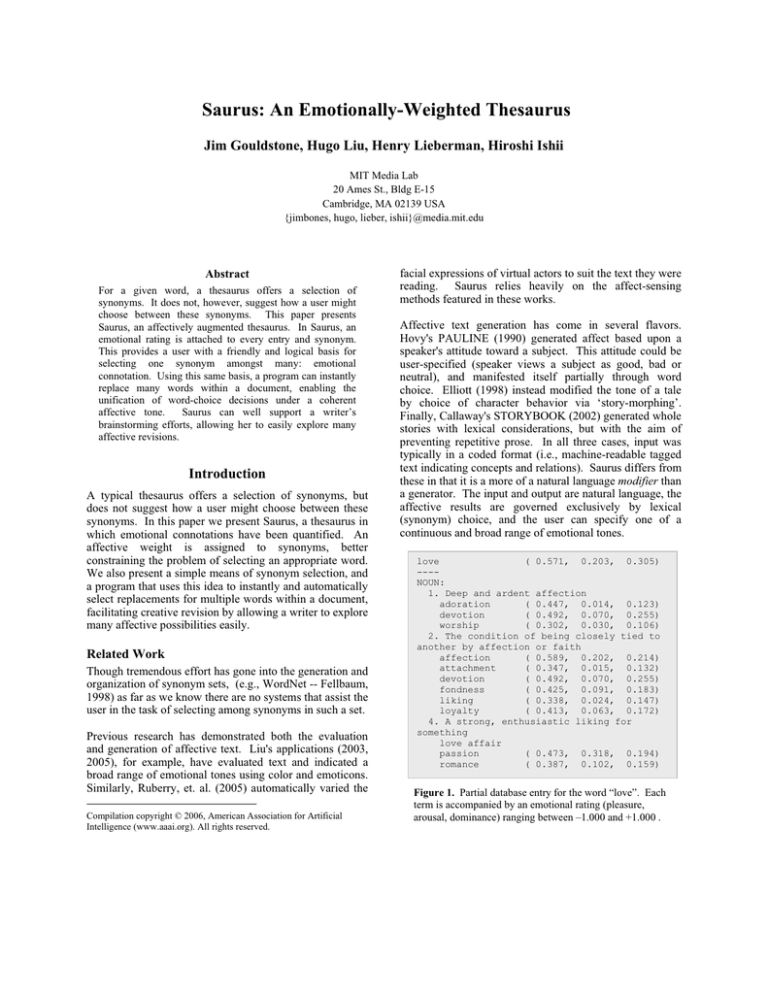
Saurus: An Emotionally-Weighted Thesaurus
Jim Gouldstone, Hugo Liu, Henry Lieberman, Hiroshi Ishii
MIT Media Lab
20 Ames St., Bldg E-15
Cambridge, MA 02139 USA
{jimbones, hugo, lieber, ishii}@media.mit.edu
Abstract
For a given word, a thesaurus offers a selection of
synonyms. It does not, however, suggest how a user might
choose between these synonyms. This paper presents
Saurus, an affectively augmented thesaurus. In Saurus, an
emotional rating is attached to every entry and synonym.
This provides a user with a friendly and logical basis for
selecting one synonym amongst many: emotional
connotation. Using this same basis, a program can instantly
replace many words within a document, enabling the
unification of word-choice decisions under a coherent
affective tone.
Saurus can well support a writer’s
brainstorming efforts, allowing her to easily explore many
affective revisions.
Introduction
A typical thesaurus offers a selection of synonyms, but
does not suggest how a user might choose between these
synonyms. In this paper we present Saurus, a thesaurus in
which emotional connotations have been quantified. An
affective weight is assigned to synonyms, better
constraining the problem of selecting an appropriate word.
We also present a simple means of synonym selection, and
a program that uses this idea to instantly and automatically
select replacements for multiple words within a document,
facilitating creative revision by allowing a writer to explore
many affective possibilities easily.
Related Work
Though tremendous effort has gone into the generation and
organization of synonym sets, (e.g., WordNet -- Fellbaum,
1998) as far as we know there are no systems that assist the
user in the task of selecting among synonyms in such a set.
Previous research has demonstrated both the evaluation
and generation of affective text. Liu's applications (2003,
2005), for example, have evaluated text and indicated a
broad range of emotional tones using color and emoticons.
Similarly, Ruberry, et. al. (2005) automatically varied the
Compilation copyright © 2006, American Association for Artificial
Intelligence (www.aaai.org). All rights reserved.
facial expressions of virtual actors to suit the text they were
reading. Saurus relies heavily on the affect-sensing
methods featured in these works.
Affective text generation has come in several flavors.
Hovy's PAULINE (1990) generated affect based upon a
speaker's attitude toward a subject. This attitude could be
user-specified (speaker views a subject as good, bad or
neutral), and manifested itself partially through word
choice. Elliott (1998) instead modified the tone of a tale
by choice of character behavior via ‘story-morphing’.
Finally, Callaway's STORYBOOK (2002) generated whole
stories with lexical considerations, but with the aim of
preventing repetitive prose. In all three cases, input was
typically in a coded format (i.e., machine-readable tagged
text indicating concepts and relations). Saurus differs from
these in that it is a more of a natural language modifier than
a generator. The input and output are natural language, the
affective results are governed exclusively by lexical
(synonym) choice, and the user can specify one of a
continuous and broad range of emotional tones.
love
( 0.571, 0.203, 0.305)
---NOUN:
1. Deep and ardent affection
adoration
( 0.447, 0.014, 0.123)
devotion
( 0.492, 0.070, 0.255)
worship
( 0.302, 0.030, 0.106)
2. The condition of being closely tied to
another by affection or faith
affection
( 0.589, 0.202, 0.214)
attachment
( 0.347, 0.015, 0.132)
devotion
( 0.492, 0.070, 0.255)
fondness
( 0.425, 0.091, 0.183)
liking
( 0.338, 0.024, 0.147)
loyalty
( 0.413, 0.063, 0.172)
4. A strong, enthusiastic liking for
something
love affair
passion
( 0.473, 0.318, 0.194)
romance
( 0.387, 0.102, 0.159)
Figure 1. Partial database entry for the word “love”. Each
term is accompanied by an emotional rating (pleasure,
arousal, dominance) ranging between –1.000 and +1.000 .
be linked. These associations are then used to suggest
weights for as yet unrated words. Specifically, the PAD
value of an initially unrated term is determined by
averaging the values of all the ANEW words with which it
is associated. This method has been used with some
success by Liu for textual affect sensing, and in this case
successfully generates weights for about 70% of the
thesaurus' 35,000 synonyms.
Note that WordNet was considered as an alternative to
OMCS for making word associations. As the relations in
WordNet are largely denotative, such associations would
have likely reinforced similarities between synonyms,
resulting in a very small spread of emotional weights
within a given synonym group.
The thesaurus is stored as human-readable text. This
allowed us to confirm that the weighting system made
intuitive sense before development continued. In Fig. 1,
the entry for the word “love”, we see that the weightings
largely agree with expectation. “Affection” is a more
pleasurable synonym than “attachment”, and “passion” is
by far the most arousing of all the synonyms.
Figure 2. The emotional tone of the harsh guide phrase,
"violent hate", is applied to a quotation, resulting in a more
negative and inflammatory choice of words.
Implementation
The Database
The heart of the system is a modified copy of Roget's II
Thesaurus.[R] The emotional weight of each entry and
synonym is appended as a PAD triplet (Mehrabian, 1995).
PAD format describes an affective tone using three
independent numerical axes: pleasure (P), arousal (A), and
dominance (D). Each axis may vary between –1.0 and
+1.0. For example, a PAD triplet with a negative D value
would suggest submissiveness, and a positive A would
suggest excitement. This representation allows for simple
programmatic comparisons between tones, as affective
similarity is reduced to Cartesian distance. For this reason,
PAD was favored over systems featuring dependent axes,
such as Ekman’s six (1993), which would have required
more complex comparisons.
The actual rating for each word is generated using
spreading activation.
A small, hand-crafted list of
weighted words (ANEW - Affective norms for English
words) (Bradley, 1999) is expanded using relations found
in a large knowledge corpus (OMCS - Open Mind
Commonsense) (Singh, 2002). We begin with 1,000+
ANEW word ratings determined by psychological focus
groups. Using the statements found in the OMCS corpus,
these rated words are linked to thousands of terms and
synonyms found in the thesaurus. Simply, if two words
appear in the same OMCS statement, they are assumed to
The User Interface
The interaction consists of three main steps, shown in Fig.
2. First, the user enters some text she wishes to alter. This
can range in size from a single word to a full document.
Second, rather than enter a PAD value directly, the user
enters a guide phrase with the intended tone. Typing
“sexy” is far simpler than visualizing and entering its PAD
triplet (0.507, 0.339, 0.283). Furthermore, suggesting a
tone by example should keep the system accessible to users
unfamiliar with PAD. Third, the program applies the
suggested tone to the original text, and displays the result.
The system confirms the tone of each step with a PAD
indicator.
The Program
The program performs three major functions: disassembly,
replacement, and reassembly. Input text is broken down
into single terms, which are in turn reduced to forms that
may be found within the database. Compare is in the
database; comparing, compared, and compares are not. So
all words are reduced to lower case, lemmatized, and their
parts of speech are identified. Next, the program attempts
to identify the sense of the words from the context. Each
word is then replaced with the synonym nearest to the
target tone. Endings appropriate to part of speech are
restored, and basic flow is improved. (e.g., During
replacement, "an automobile" may have become "an car".
This is corrected.) Finally, capitalization is restored and
the new terms reassembled. The result is a similarly
structured body of text, but with individual words swapped
out.
Initial Evaluation
Single Term Performance
For single terms, Saurus yields very promising results.
When the positive guide phrase “angel” is applied to the
term to anger, Saurus returns to bristle, a gentle-sounding
term that still conveys the mechanical meaning.
Conversely, the guide phrase “devil” returns to burn, a
harsher-sounding synonym. “Raging hell fire” yields an
even more negative and arousing result: to explode.
Finally, a neutral phrase like “potatoes and beans” results
in a less arousing term with softer connotations: to foam.
In this case, the results agree with affective expectations.
Document Performance
Saurus produces interesting results for larger bodies of text
as well. In a speech made in Sept. 2005, U.S. Senator John
Kerry criticized the government’s response to Hurricane
Katrina’s devastation of New Orleans:
The incompetence of Katrina's response is not
reserved to a hurricane. There's an enormous gap
between Americans' daily expectations and
government's daily performance.
Had the speechwriter used Saurus to modify the tone with
the guide phrase “violent hate”, Senator Kerry might have
spoken:
The incompetence of Katrina's reaction is not reserved
to a hurricane. There's a heinous breach between
Americans' daily prospects and management's daily
execution.
Several of the words have been replaced with those that
have more negative connotations. Most notably, the
“enormous gap” has become a “heinous breach”. Also, it
is interesting to note that the negative tone of some
replacement words comes not from their present usage
(execution meaning operation) but from another of their
senses (execution meaning capital punishment).
Note that the program is evaluating the tone of the guide
phrase, not the meaning. Strong phrases are used here
because they yield livelier results. The speechwriter could
have employed the phrase “everlasting love” to instead
soften the criticism:
The incapability of Katrina's answer is not reserved to
a hurricane. There's a heroic incongruity between
Americans' daily expectancies and governance's daily
performance.
Here, “heroic incongruity” still means “enormous gap”, but
the term heroic has many positive connotations.
“Incompetence” which implies an almost willful ineptitude
has become “incapability”, which instead conveys a kind
of blameless inability.
Word Sense Disambiguation
Though the above results are encouraging, the system can
produce nonsensical results. Most commonly, this is due
to the program choosing the incorrect meaning for a
particular word. The following is a quote from The
Washington Post regarding Iraqi elections:
Polls opened at 7 am Thursday for nationwide
elections in Iraq, with a large explosion in central
Baghdad moments later serving as a reminder of
recurrent violence. (E. Knickmeyer, Dec.15, 2005)
After modification by Saurus, it reads:
Heads extended at 7 am Thursday for nationwide
choices in Iraq, with a substantial outbreak in key
Baghdad imports afterward serving as a remembrance
of cyclic coercion.
This example clearly illustrates the program’s word sense
disambiguation difficulties. Part of speech locks have been
added to the interface in response to this. The user can
uncheck NOUN, VERB, ADVERB, and/or ADJECTIVE
in the interface, specifying that the program leave words of
that type unchanged. The assumption was that the “how”
elements (adverbs and adjectives) might be more faulttolerant than the “what” elements (nouns and verbs) of a
sentence. Here is the above example again, but with verbs
and nouns locked:
Polls opened at 7 am Thursday for nationwide
elections in Iraq, with a substantial explosion in key
Baghdad moments afterward serving as a reminder of
cyclic violence.
Unexpected Results
Finally, some word sense mix-ups can be entertaining.
They are most effective when multiple sequential words
have their mechanical meaning drastically altered, but the
sentence continues to make sense. A grandfather searching
for his grandchild might say, “Where’s my pretty little girl,
eh?” but Saurus muddles the senses and asks, “Where’s
my fairly inconsequential girl, eh?”
Interface Performance
The interface works well for smaller bodies of text (4-5
lines). The PAD indicators help to quantify and compare
tones, and the equally sized input and output text areas
make it easy to spatially match a word with its
replacement.
Larger documents are not so easily
evaluated, however. As number of words grows, the PAD
value for a body always approaches a single neutral value.
(Thus, guide phrases are best kept short.) Also, changes in
word length alter how the text wraps, making it difficult to
spatially pair a word with its original. A more consistent
word layout should ameliorate this.
Applications
There are many uses for a system that can quickly and
automatically alter written tone. Of course, professional
and amateur writers can use it to experiment with phrasing,
whether describing a scene, or composing character dialog.
There are also several less obvious uses.
is never left guessing what has gone wrong. It is usually
quite clear that the wrong sense has been used. Though
this transparency should make a user more forgiving, more
reliable performance would be welcome.
References
Political Spin – Public figures can instantly comment on
their own mistakes or successes in favorable tone, and
respond to opponents in a more critical tone.
Bradley, M.M., and Lang, P.J. 1999. Affective norms for
English words (ANEW). The NIMH Center for the Study
of Emotion and Attention, University of Florida.
Video Game Characters – Computer controlled characters
can speak what is essentially the same dialog in a range of
different tones, depending upon their attitude towards the
player.
Callaway, C. and Lester, J. 2002. Narrative Prose
Generation. Artificial Intelligence 139(2):213—252.
Ekman, P. 1993. Facial expression of emotion. American
Psychologist, 48, 384—392.
Children’s Stories – Saurus could be modified to examine
every word in a document and exaggerate its tone. Wicked
witches become diabolical, dark villains sinister, and
mighty heroes gargantuan, making the story larger than
life. (Conversely, a document intended for legal purposes
could be made to sound more neutral.)
Elliott, C., Brzezinski, J., Sheth, S., and Salvatoriello, R.
1998. Story-morphing in the affective reasoning paradigm.
In Proceedings of the Second International Conference on
Autonomous Agents, 181-188. Minneapolis, Minnesota.
Three-stage Poetry - An experimental poet could compose
the mechanical and emotional meanings of a poem in two
separate works, structure in one, and feeling in another.
They could then be overlapped, line by line, to produce a
complete result.
Hovy, E. 1990. Pragmatics and natural language
generation. Artificial Intelligence d3(2):153-197.
Reader Preferences - A netizen reading from a particularly
aggressive forum or slanted news source could subtly alter
the tone to something more agreeable.
Foreign Language - Another use could be in language
learning. Subtleties of strength of meaning are hard for
non-native speakers to pick up (e.g., Which connotes the
strongest praise in French: aimable, amicale, sympathique,
gentil?).
Conclusion & Future Work
It is possible to programmatically classify words beyond
simple literal meaning. Saurus has demonstrated that it is
also possible to use an augmented thesaurus to ease user
synonym selection through the use of an affective guide
phrase.
Furthermore, this method can be used to
automatically select and replace multiple synonyms, thus
changing the tone of an entire document while preserving
its basic literal meaning. Such a system can greatly assist
writers, allowing them to quickly generate and explore
many affective revisions.
Though Saurus has demonstrated some interesting ideas, it
needs more work before it can be counted on to reliably
produce readable documents. Nearly all of the work that
needs to be done involves word sense disambiguation.
Any solid gains in Saurus’ WSD ability will be
immediately apparent in its output. Concurrently, effort
should be made to make the system more fault-tolerant, or
fail-soft. The system has a fail-soft aspect in that the user
Fellbaum C. ed. 1998. WordNet: An Electronic Lexical
Database. MIT Press.
Liu, Hugo. 2004. MontyLingua: An end-to-end natural
language processor with common sense. Available at:
web.media.mit.edu/~hugo/montylingua.
Liu, H., Lieberman, H., and Selker, T. 2003. A model of
textual affect sensing using real-world knowledge. In
Proceedings of the 8th International Conference on
Intelligent User Interfaces. Miami, Florida.
Liu, H. and Maes, P. 2005. The Aesthetiscope: visualizing
aesthetic readings of text in color space. In Proceedings of
the Eighteenth International Florida Artificial Intelligence
Research Society Conference (AI in Music & Art Special
Track). 74-79. Menlo Park, Calif.: AAAI Press.
Liu, H., Selker, T., and Lieberman, H. 2003. Visualizing
the Affective Structure of a Text Document. In
Proceedings of CHI, 740-741.
Mehrabian, A. 1995. Framework for a comprehensive
description and measurement of emotional states. Genetic,
Social, and General Psychology Monographs 121:339361.
Roget’s II: The New Thesaurus, 3rd ed. Boston: Houghton
Mifflin, 1995. www.bartleby.com/62/.
Ruberry, M., Owsley, S., Shamma, D.A., Hammond, K.,
and Budzik, J. 2005. Affective Behaviors for Theatrical
Agents. In Workshop on Affective Interactions,
International Conference on Intelligent User Interfaces.
Singh, P., 2002 The Public Acquisition of Commonsense
Knowledge. In Proceedings of AAAI Spring Symposium.
Palo Alto, CA: AAAI.

